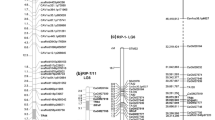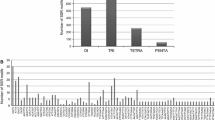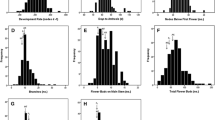Abstract
Seed traits are important considerations for improving yield and product quality of chickpea (Cicer arietinum L.). The purpose of this study was to construct an intraspecific genetic linkage map and determine map positions of genes that confer double podding and seed traits using a population of 76 F10 derived recombinant inbred lines (RILs) from the cross of ‘ICCV-2’ (large seeds and single pods) × ‘JG-62’ (small seeds and double podded). We used 55 sequence-tagged microsatellite sites (STMS), 20 random amplified polymorphic DNAs (RAPDs), 3inter-simple sequence repeats (ISSR) and 2 phenotypic markers to develop a genetic map that comprised 14 linkage groups covering297.5 cM. The gene for double podding (s) was mapped to linkage group 6 and linked to Tr44 and Tr35 at a distance of7.8 cM and 11.5 cM, respectively. The major gene for pigmentation, C, was mapped to linkage group 8 and was loosely linked to Tr33 at a distance of 13.5 cM. Four QTLs for 100 seed weight (located on LG4 and LG9), seed number plant-1 (LG4), days to 50% flower (LG3) were identified. This intraspecific map of cultivated chickpea is the first that includes genes for important morphological traits. Synteny relationships among STMS markers appeared to be conserved on six linkage groups when our map was compared to the interspecific map presented by Winter et al. (2000).
Similar content being viewed by others
References
Ahmad, N., 1964. Inheritance of pod characters in Cicer species and its economic importance. West Pakist J Agric Res 2: 58–61.
Ahmad, F. & A.E. Slinkard, 1992. Genetic relationships in the genus Cicer L. as revealed by polyacrylamide gel electrophoresis of seed storage proteins. Theor Appl Genet 84: 688–692.
Areshchencova, T. & M.W. Ganal, 1999. Long tomato microsatellites and predominantly associated with centromeric regions. Genome 42: 536–544.
FAO, 1998. Production year book. Vol. 52.
Ghatge, R.D., 1993. Inheritance of seed size in Chickpea (Cicer arietinum L.). J Soils & Crops 3: 56–59.
Hüttel, B., P. Winter, K. Weising, W. Choumane, F. Weigand & G. Kahl, 1999. Sequence-tagged microsatellite site markers for chickpea (Cicer arietinum L.) Genome 42: 210–217.
Kazan, K., F.J. Muehlbauer, N.W. Weeden & G. Ladizinsky, 1993. Inheritance and linkage relationships of morphological and isozyme loci in chickpea. Theor Appl Genet 86: 417–426.
Khan, A.R. & A.R. Akhtar, 1934. The inheritance of petal colour in gram. Agric Livestock India 4: 127–155.
Kumar, S. & O. Singh, 1995. Inheritance of seed size in chickpea. J Genetics & Breeding 49: 99–103.
Kumar, J., R.K. Srivastava & M. Ganesh, 2000. Penetrance and expressivity of the gene for double podding in chickpea. J Hered 91: 234–236.
Kumar, J. & H.A. van Rheenen, 2000. A major gene for time of flowering in chickpea. J Hered 91: 67–68.
Kumar, J., N.V.S. Vijayalaxmi & T.N. Rao, 2000. Inheritance of flower color in chickpea. J Hered 91: 416–417.
Lander, E.S., P. Green, J. Abrahamson, E. Barlow, M.J. Daly, S.E. Lincoln & L. Newberg, 1987. MAPMAKER: an interactive computer package for constructing primary genetic linkage maps of experimental and natural populations. Genomics 1: 174–181.
Malhotra, R.S, B. Geletu & K.B. Singh, 1997. Inheritance of seed size in chickpea. J Genetics & Breeding 51: 45–50.
Muehlbauer, F.J. & K.B. Singh, 1987. Genetics of Chickpea. In: M.C. Saxena & K.B. Singh (Eds.), The Chickpea, pp. 99–126. CAB International.
Nelson, J.C., 1997. QGENE: software for maker-based genomic analysis and breeding. Mol Breed 3: 239–245.
Niknejad, M., M. Khosh-khui & S.R. Ghorashy, 1971. Inheritance of seed size in chickpea (Cicer arietinum L.). Crop Sci 11: 768–769.
Or, E., R. Hovav & S. Abbo, 1999. A major gene for flowering time in chickpea. Crop Sci 39: 315–322.
Prosky, L., N.G. Asp, T.F. Schweitzer, J.W. Devries & J. furda, 1988. Determination of insoluble, soluble and total dietary fiber in foods and food products: Interlaboratory study. J Assoc Off Anal Chem 71: 1017–1023.
Ryan, J.G., 1997. A global perspective on pigeon pea and chickpea sustainable production systems-present status and future potential. In: A.P. Asthana & Masood Ali (Eds.), Recent Advances in Pulses Research, pp. 1–31. Indian Society of Pulses Research and Development, Kanpur, India.
Santra, D.K., M. Tekeoglu, W.J. Kaiser & F.J. Muehlbauer, 2000. Identification and mapping of QTLs conferring resistance to ascochyta blight in chickpea. Crop Sci 40: 1606–1612.
Schmit, T. & J.S. Heslop-Harrison, 1996. The physical and genomic organization of microsatellites in sugar beet. Proc Natl Acad Sci USA 93: 8761–8765.
Sheldrake, A.R., N.P. Saxena & L. Krishnamurthy, 1979. The expression and influence on yield of the double-podded character in chickpea (Cicer arietinum L.). Field Crops Res 1: 243–253.
Simon, C.J. & F.J. Muehlbauer, 1997. Construction of a chickpea linkage map and its comparison with maps of pea and lentil. J Hered 88: 115–119.
Weising, K., H. Nybom, K. Wolff & W. Meyer, 1995. DNA Fingerprinting in Plants and Fungi. CRC Press, Boca Raton.
Winter, P., T. Pfaff, S.M. Udupa, B. Hüttel, P.C. Sharma, S. Sahi, R. Arreguin-Espinoza, F. Weigand & F.J. Muehlbauer, 1999. Characterization and mapping of sequence-tagged microsatellite sites in the chickpea (Cicer arietinum L.) genome. Mol Gen Genet 262: 90–101.
Winter, P., A.M. Benko-Iseppon, B. Hüttel, M. Ratnaparkhe, A. Tullu, G. Sonnante, T. Pfaff, M. Tekeoglu, D. Santra, V.J. Sant, P.N. Rajesh, G. Kahl & F.J. Muehlbauer, 2000. A linkage map of chickpea (Cicer arietinum L.) genome based on recombinant inbred lines from a C. arietinum × C. reticulatum cross: Localizaton of resistance genes for fusarium wilt races 4 and 5. Theor Appl Genet 101: 1155–1163.
Author information
Authors and Affiliations
Rights and permissions
About this article
Cite this article
Cho, S., Kumar, J., Shultz, J.L. et al. Mapping genes for double podding and other morphological traits in chickpea. Euphytica 128, 285–292 (2002). https://doi.org/10.1023/A:1020872009306
Issue Date:
DOI: https://doi.org/10.1023/A:1020872009306




